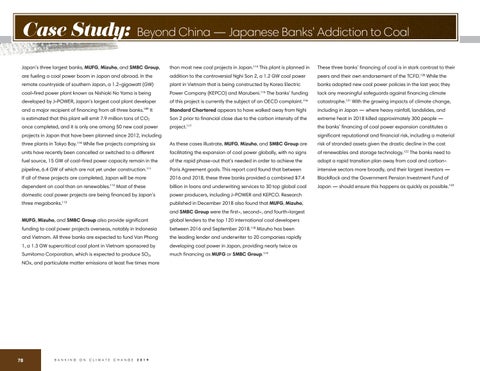Case Study:
Beyond China — Japanese Banks' Addiction to Coal
Japan’s three largest banks, MUFG, Mizuho, and SMBC Group,
than most new coal projects in Japan.114 This plant is planned in
These three banks’ financing of coal is in stark contrast to their
are fueling a coal power boom in Japan and abroad. In the
addition to the controversial Nghi Son 2, a 1.2 GW coal power
peers and their own endorsement of the TCFD.120 While the
remote countryside of southern Japan, a 1.2-gigawatt (GW)
plant in Vietnam that is being constructed by Korea Electric
banks adopted new coal power policies in the last year, they
coal-fired power plant known as Nishioki No Yama is being
Power Company (KEPCO) and Marubeni.
developed by J-POWER, Japan’s largest coal plant developer
of this project is currently the subject of an OECD complaint.116
catastrophe.121 With the growing impacts of climate change,
and a major recipient of financing from all three banks.109 It
Standard Chartered appears to have walked away from Nghi
including in Japan — where heavy rainfall, landslides, and
is estimated that this plant will emit 7.9 million tons of CO2
Son 2 prior to financial close due to the carbon intensity of the
extreme heat in 2018 killed approximately 300 people —
once completed, and it is only one among 50 new coal power
project.
the banks’ financing of coal power expansion constitutes a
115
The banks’ funding
117
projects in Japan that have been planned since 2012, including
lack any meaningful safeguards against financing climate
significant reputational and financial risk, including a material
While five projects comprising six
As these cases illustrate, MUFG, Mizuho, and SMBC Group are
risk of stranded assets given the drastic decline in the cost
units have recently been cancelled or switched to a different
facilitating the expansion of coal power globally, with no signs
of renewables and storage technology.122 The banks need to
fuel source, 15 GW of coal-fired power capacity remain in the
of the rapid phase-out that’s needed in order to achieve the
adopt a rapid transition plan away from coal and carbon-
pipeline, 6.4 GW of which are not yet under construction.111
Paris Agreement goals. This report card found that between
intensive sectors more broadly, and their largest investors —
If all of these projects are completed, Japan will be more
2016 and 2018, these three banks provided a combined $7.4
BlackRock and the Government Pension Investment Fund of
dependent on coal than on renewables.112 Most of these
billion in loans and underwriting services to 30 top global coal
Japan — should ensure this happens as quickly as possible.123
domestic coal power projects are being financed by Japan’s
power producers, including J-POWER and KEPCO. Research
three megabanks.113
published in December 2018 also found that MUFG, Mizuho,
three plants in Tokyo Bay.
110
and SMBC Group were the first-, second-, and fourth-largest MUFG, Mizuho, and SMBC Group also provide significant
global lenders to the top 120 international coal developers
funding to coal power projects overseas, notably in Indonesia
between 2016 and September 2018.118 Mizuho has been
and Vietnam. All three banks are expected to fund Van Phong
the leading lender and underwriter to 20 companies rapidly
1, a 1.3 GW supercritical coal plant in Vietnam sponsored by
developing coal power in Japan, providing nearly twice as
Sumitomo Corporation, which is expected to produce SO2,
much financing as MUFG or SMBC Group.119
NOx, and particulate matter emissions at least five times more
78
B A N K I N G
O N
C L I M A T E
C H A N G E
2 0 1 9
